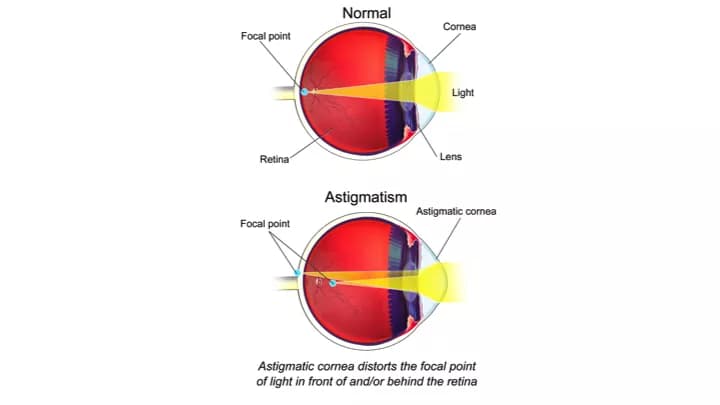What are the other Names for this Condition? (Also known as/Synonyms)
- Astigmia
- Cylindrical Refractive Error
What is Astigmatism? (Definition/Background Information)
- Astigmatism is an eye disorder caused by the irregular shape and curvature of the cornea or lens. It is classified as a refractive error of the eye
- Refraction is the bending of light when it passes from one medium to another. Therefore, refractive error denotes a condition wherein the shape of one’s eyes does not allow the light to bend correctly, so as to fall on the central part of the retina called fovea, which is responsible for sharpness of vision. This results in blurred vision
- It is generally accepted that genetic factors have a significant role in determining ocular refractive status as well as Astigmatism. But, many conditions and procedures, such as surgery, scarring following infections, trauma, and ocular comorbidities, are known to modify the cylindrical status of the eye
- Individuals with Astigmatism have an unusually shaped cornea, and the light is focused on 2 different planes that create a blurred vision. The condition usually affects children and adolescents between 5-17 years of age, and adults over the age of 30 years
- There are many types of classification of Astigmatism. Chiefly, it is classified into the following two types:
- Corneal Astigmatism (due to abnormal curvature of the cornea)
- Lenticular Astigmatism (due to abnormal curvature of the lens)
- A family history of the condition, premature birth, low birth weight, and a recent eye surgery are some known risk factors for the development of Astigmatism. Important causes for the condition include abnormal curvature and shape of the cornea or lens due to a variety of factors, such as keratoconus, which can result from injury to the eye
- Some common symptoms associated with this condition include blurring of vision, eye strain, headache, and dizziness. Astigmatism can lead to the development of amblyopia (or “lazy eye”), an optical disorder characterized by partial or complete loss of vision
- The treatment for Astigmatism depends upon its severity. While mild cases may not require any treatment; for more severe conditions, the use of contact lenses or surgery may be advocated to correct refractive errors successfully. Surgery is generally reported to correct the condition
- However, contact lenses used for the correction of Astigmatism can lead to corneal abrasion. Also, a corrective surgery may potentially lead to infections, redness, and vision problems
- Astigmatism is known to change with age, and therefore, adjustment of lenses or other treatment measures may be required. The prognosis is considered to be good, if one keeps up with the treatment course and undertakes regular follow-up checks
- Reading in proper light, avoiding eye strain, and getting one’s eyes examined regularly if one is at risk for Astigmatism, are some known methods for preventing this eye condition
Who gets Astigmatism? (Age and Sex Distribution)
- Children between the age group of 5 and 17 years and adults over the age of 30 years are reported to be vulnerable to Astigmatism
- Like many other refractive errors of the eye, this condition is observed worldwide. There is no racial or ethnic group preference observed
What are the Risk Factors for Astigmatism? (Predisposing Factors)
The risk factors known to be associated with Astigmatism include:
- Having a family history of the condition
- Preterm birth; low birth weight
- Advancing age
- Eye surgery, such as a cataract surgery, may result in Astigmatism
- Corneal scarring due to injury
- Corneal thinning
- Pre-existing refractive errors of the eye such as myopia (near-sightedness) or hypermetropia (far-sightedness)
- Severe allergies resulting in constant rubbing of the eyes
- Uncontrolled diabetes
It is important to note that having a risk factor does not mean that one will get the condition. A risk factor increases one's chances of getting a condition compared to an individual without the risk factors. Some risk factors are more important than others.
Also, not having a risk factor does not mean that an individual will not get the condition. It is always important to discuss the effect of risk factors with your healthcare provider.
What are the Causes of Astigmatism? (Etiology)
There are two types of Astigmatism that include Corneal Astigmatism and Lenticular Astigmatism. The possible causes for the two types include:
- Corneal Astigmatism:
- Oval-shaped cornea
- Scarring of the cornea due to infections, injuries, or surgery to the eye (trauma)
- Keratoconus: A disorder of the eye causing the cornea to thin and changing it to a conical shape
- Lenticular Astigmatism:
- Variation in the shape of the lens
- Uncontrolled diabetes
Astigmatism can also be classified as regular and irregular depending upon the measured curvature of the eye.
- Regular Astigmatism: The most common cause of this type of disorder is a congenital defect (causing Congenital Astigmatism). It is most common type of Astigmatism
- Irregular Astigmatism: The most common causes include scarring of the cornea and thinning of the cornea, due to corrective eye surgery
Some researchers and healthcare providers also classify Astigmatism into the following categories:
- Myopic Astigmatism: If both the angles of Astigmatism (measured using optical instruments) are nearsighted (or myopic), the condition is called Myopic Astigmatism
- Hyperopic Astigmatism: If both the angles of Astigmatism (measured using optical instruments) are farsighted (or hyperopic), the condition is called Hyperopic Astigmatism
- Mixed Astigmatism: If one angle is nearsighted and the other angle is farsighted, then the condition is called Mixed Astigmatism
What are the Signs and Symptoms of Astigmatism?
Some characteristic signs and symptoms of Astigmatism include:
- Blurred vision or distorted vision
- Eye strain
- Dizziness
- Headaches
- Constant closing of one’s eyes
- Ability to view and focus clearly, only when part of an eye is closed during an optical examination
How is Astigmatism Diagnosed?
The diagnosis of Astigmatism may involve the following tests and exams:
- Visual acuity test: In this test, letters are arranged in lines with each line containing different sized letters
- Astigmatic dial test: Under this method, the lines are arranged in a semi-circle to assess one’s vision
- Examination with a keratometer (also known as an ophthalmometer) helps in measuring the following:
- The light reflected from the surface of the cornea
- Radius of the curve of cornea
- Degree of abnormality in the curve of cornea
- Automated computerized keratometer called corneal topography (Pentacam) is used to analyze the curvature of cornea in special conditions, such as early keratoconus, high corneal astigmatism, and also before refractive surgery
- Autorefractometer is employed routinely nowadays to routinely measure Astigmatism along with refractive error
- Regular and periodical eye checkups: It is highly recommended that children undergo a thorough eye check up from age four years; adults should have a regular eye checkup once every two years
Many clinical conditions may have similar signs and symptoms. Your healthcare provider may perform additional tests to rule out other clinical conditions to arrive at a definitive diagnosis.
What are the possible Complications of Astigmatism?
Some potential complications associated with Astigmatism include:
- Amblyopia (or "lazy eye") - impaired vision in one eye
- Corneal abrasion: The use of contact lens to treat Astigmatism may lead to irritation and abrasion to the cornea, especially when the contact lens is not cleaned and maintained properly
- Many individuals have a combination of Astigmatism and nearsightedness/farsightedness
The side effects of surgery may include:
- Infection
- Inflammation
- Redness to the eye
- Severe vision problems
How is Astigmatism Treated?
A mild case of Astigmatism may not need any special medical attention. In other cases, following are the treatment measures for Astigmatism:
- A refractive error can be corrected with the help of corrective lenses that allow the image to fall properly on the retina. Corrective lenses may be in the form of eyeglasses or contact lenses
- The types of contact lenses that can be used in the treatment include:
- Soft toric contact lenses
- Gas permeable contact lenses
- Hybrid contact lenses
- Laser eye surgery such as:
- Photorefractive keratectomy (PRK) for Astigmatism
- Laser epithelial keratomileusis (LASEK) for Astigmatism
- Laser in situ keratectomy (LASIK) for Astigmatism
How can Astigmatism be Prevented?
Some known measures for preventing Astigmatism include:
- Avoiding eye strain
- Reading in proper light
- Avoiding excessive rubbing of the eyes: Treating severe allergies can eliminate constant rubbing of the eyes, which is a risk factor for Astigmatism
- Following a healthy diet that includes fruits and vegetables
- Doing eye exercises for improving vision and reducing refractive errors, upon recommendation by a healthcare specialist
- Keeping the eye safe from injuries
- Getting one’s eyes examined regularly
What is the Prognosis of Astigmatism? (Outcomes/Resolutions)
- Astigmatism is a treatable condition through corrective eyewear or surgery and the prognosis is generally excellent
- However, the condition could change with age and accordingly, corrective measures might be needed to avoid eye strain or other complications
Additional and Relevant Useful Information for Astigmatism:
- Laser in-situ keratomileusis (Lasik) is a procedure to improve vision by reshaping the cornea, using excimer (ultraviolet) laser
The following article link will help you understand laser in-situ keratomileusis surgical procedure:
http://www.dovemed.com/common-procedures/procedures-surgical/laser-in-situ-keratomileusis-lasik/
Related Articles
Test Your Knowledge
Asked by users
Related Centers
Related Specialties
Related Physicians
Related Procedures
Related Resources
Join DoveHubs
and connect with fellow professionals



0 Comments
Please log in to post a comment.